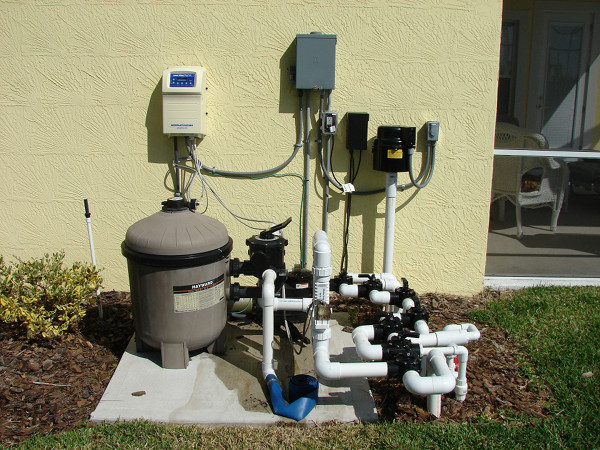
Reviewed by Andrada Simion, Master of Science in Chemistry
- Pool pumps deliver optimal filtration two full cycles per day. A cycle refers to the turnover rate, which ranges from 6-10 hours. For ideal swimming conditions, the pump should run at least eight hours at a time. One rule for determining the amount of time is one hour for every ten degrees (farenheit) outside. Generally, in summer, one wants it operating between 10-12 hours at a time. In harsh winter climates, this increases to 14-24 hours to prevent the pool from freezing over. In milder winters, this decreases to only approximately eight.
- Running the pool pump overnight, during off peak hours (9:00 PM – 8:00 AM), saves money but is less efficient. In order for the pump to be fully effective, run it during daylight. Even those who run it at night admit that water needs to circulate somewhat during the day.
- When the Sun is shining, UV rays destroy chlorine. If the water is uncovered and still, there is a significant risk for chlorine depletion. Two cycles during daylight keeps the water moving under intense sunlight, protecting the Chlorine. While doing this at night leaves the pool still and vulnerable during the hottest times of the day. Chlorine deficiency can lead to algae or other bacteria. The pool water can become cloudy and unsafe. Short term savings from nighttime operations may not be worth it if the pool becomes dirty and requires expensive treatments.
- Families are also much more likely to use the pool during the day. The pool pump will filter out common contaminants that affect water quality, such as sunscreen, sweat, or dirt. This will keep the water clean and clear. Although pumping during the day may raise the electric bill, it will allow for long term savings.
- However, there are a few instances in which the pump should run at night. For example, if the pool is undergoing chemical treatments, such as algae-clean up or shock treatment. In these cases, leaving the pool still during the day will allow the Sun to kill excess chlorine.
- It has become common in southern states to split up run times. This means that instead of one 6-10 hour run, they will run the pump for four hours in the morning and four in the evening. The first cycle should occur between 11:00 AM and 4:00 PM, when sunlight is most intense. The second cycle will occur after sundown, but this risks chlorine buildup. Thus, continuous cycling is the most effective method. It is also easier to remember to turn on the pump once a day than twice.
- Practically speaking, pool pumps can be very loud. Operating at night when the neighborhood is trying to sleep can be inconsiderate and impolite.
- To reduce the energy costs from daytime filtration, try covering the pool for a few hours. The dark cover will reduce the amount of sunlight that reaches the water, protecting the chlorine.
- To save money in the long run without having to run a pump at night, invest in a variable speed pump. Although they are an expensive one time purchase, they can lower energy costs by over 50%.
- For the best swimming conditions, ensure that the pump completes two full cycles during the day. However, do not leave it running 24 hours. Although the water will be pristine, the pump will break down from excess use, and the electricity bill will spike. Clean out the filter baskets every day to prevent clogging. This will help the pump run more efficiently. Another solution is lowering the pressure. Check the pressure gauge on the pool filter regularly. A system operating at just 10 PSI above normal can cost $3000 a year. Increasing the size of your plumbing system allows for less pressure. This can be quite a hands-on project, but results in big savings.